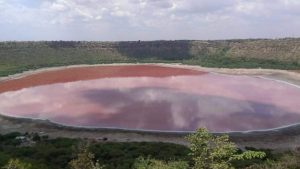Table of Contents
Daily Current Affairs for Government Exams:
Today Current Affairs: 12th June 2020 for UPSC IAS exams, State PSC exams, SSC CGL, State SSC, RRB, Railways, Banking Exam & IBPS, etc
Contents:
- India Rankings 2020” for Higher Educational Institutions:
- Adjusted Gross Revenue (AGR) :
- Nature Index table 2020:
- International Criminal Court (ICC):
- New guidelines for import of exotic species:
- Lonar Lake
- Other important current affairs
1. “India Rankings 2020” for Higher Educational Institutions:

Union HRD Minister released “India Rankings 2020” for Higher Educational Institutions in various categories on the basis of their performance on five broad categories of parameters.
- This is the fifth consecutive edition of India Rankings of the institutions of higher education by the Ministry of Human Resource Development (MHRD).
- The National Institutional Ranking Framework (NIRF), launched in 2015, outlines a methodology to rank institutions across the country.
- The ranking framework evaluates institutions on five parameters –
- Teaching, Learning, and Resources (TLR) – 30% Weightage
- Research and Professional Practice (RP) – 40%
- Graduation Outcomes (GO) – 5%
- Outreach and Inclusivity (OI) – 15%
- Perception (PR) – 10%
- Dental institutions have been included for the first time in “India Rankings” bringing the total tally to 10 categories/subject domains.
List of institutes which secured top rank in ‘India Rankings 2020’ in various categories:
- Overall: Indian Institute of Technology Madras
- University: Indian Institute of Science, Bengaluru
- Engineering: Indian Institute of Technology Madras
- Management: Indian Institute of Management Ahmedabad
- Colleges: Miranda House, Delhi
- Pharmacy: Jamia Hamdard, New Delhi
- Medical: All India Institute of Medical Sciences, New Delhi
- Architecture: Indian Institute of Technology Kharagpur
- Law: National Law School of India University, Bengaluru
- Dental: Maulana Azad Institute of Dental Sciences, Delhi
2.Adjusted Gross Revenue (AGR) :

The Supreme Court has said it was “totally impermissible” for the Department of Telecommunications (DoT) to “misuse” a judgment of the Apex Court to demand ₹4 lakh crore in adjusted gross revenue (AGR) from public sector undertakings.
- The Court has also questioned the viability of the government’s 20-year ‘formula’ for telecom companies to repay their AGR dues to the tune of ₹1.42 lakh crore.
- The Court pointed out its October 2019 judgment which was completely silent with regard to public sector undertakings.
- The government told the Court that it would file an affidavit explaining as to why the AGR demands were raised against the PSUs.
- Last year, the Supreme Court upheld the definition of Adjusted Gross Revenue (AGR) calculation as stipulated by the Department of Telecommunications.
- The order by the top court means that the telecom companies will have to immediately clear the pending AGR dues, which amount to nearly Rs 1.47 lakh crore.
AGR:
- Adjusted Gross Revenue (AGR) is the usage and licensing fee that telecom operators are charged by the Department of Telecommunications (DoT).
- It is divided into spectrum usage charges and licensing fees, pegged between 3-5 percent and 8 percent respectively.
4.Nature Index table 2020:

In the recently-released Nature Index table 2020, India is placed twelfth globally in science research output. The top five positions have gone to the United States of America, China, Germany, the United Kingdom, and Japan.
- The Nature Index is a database of author affiliation information collated from research articles published in an independently selected group of 82 high-quality science journals.
- The database is compiled by Nature Research, a division of the international scientific publishing company Springer Nature that publishes academic journals. Nature Research’s flagship publication is Nature, a weekly multidisciplinary journal first published in 1869.
- The Nature Index provides a close to the real-time proxy of high-quality research output and collaboration at the institutional, national, and regional levels.
- The Nature Index is updated monthly and also releases annual tables of country.
Key findings of Nature Index, 2020 on India:
- Globally the top-rated Indian institutions in this list are Council of Scientific and Industrial Research (CSIR), a group of 39 institutions at the 160th position and Indian Institute of Science (IISc) Bangalore at the 184th position.
- Three of the autonomous institutions of the Department of Science & Technology, Government of India have found their place among the top 30 Indian Institutions as per Nature Index 2020 ratings.
- These are
- the Indian Association for the Cultivation of Science (IACS), Kolkata at 7th position,
- Jawaharlal Nehru Centre for Advanced Scientific Research (JNCASR), Bangalore at 14th position and
- N. Bose National Centre for Basic Sciences, Kolkata at 30th position.
5.International Criminal Court (ICC):

U.S. President Donald Trump has issued an executive order authorizing sanctions against individuals involved in an International Criminal Court (ICC) investigation into whether U.S. forces committed war crimes in Afghanistan.
- The order authorizes Secretary of State to block assets in the U.S. of ICC employees involved in the probe
It also authorizes to block entry into the U.S. of these individuals. - ICC prosecutor Fatou Bensouda wants to investigate possible crimes committed between 2003 and 2014, including alleged mass killings of civilians by the Taliban, as well as the alleged torture of prisoners by Afghan authorities and, to a lesser extent, by U.S. forces and the CIA.
- The ICC decided to investigate after prosecutors’ preliminary examination in 2017 found reasonable grounds to believe war crimes were committed in Afghanistan and that the ICC has jurisdiction.
- Mr. Trump has repeatedly attacked The Hague-based ICC set-up to prosecute war crimes, genocide and crimes against humanity. He says, the Court has jurisdiction only if a member state is unable or unwilling to prosecute atrocities itself.
- Besides, the U.S. government has never been a member of the court.
About ICC:
- The International Criminal Court (ICC), located in The Hague, is the court of last resort for prosecution of genocide, war crimes, and crimes against humanity.
- It is the first permanent, treaty-based, international criminal court established to help end impunity for the perpetrators of the most serious crimes of concern to the international community.
- Its founding treaty, the Rome Statute, entered into force on July 1, 2002.
- The Court’s management oversight and legislative body, the Assembly of States Parties, consists of one representative from each state party.
- Each state party has one vote and “every effort” has to be made to reach decisions by consensus. If consensus cannot be reached, decisions are made by vote.
- The Assembly is presided over by a president and two vice-presidents, who are elected by the members to three-year terms.
6.New guidelines for import of exotic species:

Union Government has issued advisory to streamline the process for import and possession of exotic live species in India.
- The move comes as the outbreak of coronavirus (COVID-19) has raised global concern about illegal wildlife trade and zoonotic diseases.
- Exotic live species are animal or plant species moved from their original range to a new one most often by people.
- Some of the most sought after exotic species in India are Ball python, Scarlet Macaw, sea turtles, sugar glider (Petaurus breviceps), marmoset, and grey African parrots.
- According to the advisory, the phrase “exotic live species” includes “animals named under the Appendices I, II and III of the Convention of International Trade in Endangered Species of Wild Fauna and Flora” and “does not include species from the Schedules of the Wildlife (Protection) Act 1972”.
Recently released guidelines:
- Environment Ministry will collect stock information from the holders of such species through voluntary disclosure in the next six months.
- The registration will be done for the stock of animals, new progeny, as well as for import and exchange.
- The declarer would not be required to produce any documentation in relation to the exotic live species if the same has been declared within six months of the date of the issue of the advisory.
- For any declaration made after six months, the declarer shall be required to comply with the documentation requirement under the extant laws and regulations.
- Further, a person trying to import a live exotic animal will have to submit an application for grant of a license to the Directorate General of Foreign Trade (DGFT), under the provisions of the advisory.
- The importer will also have to attach a No Objection Certificate (NOC) of the chief wildlife warden of the state concerned along with the application.
7.Lonar lake:

Recently, the water in the Lonar lake in the Buldhana district of Maharashtra was found to be turning reddish over the past few days.
- The local administration of the district has requested the National Environmental Engineering Research Institute (NEERI), Nagpur, to find out the reason behind it.
- The color of water in Maharashtra’s Lonar lake, also known as Lonar crater, has changed to red.
- It is said to be normal when the lake gets rainwater.
- Probable Reasons:
- Algal Bloom:
An algal bloom or algae bloom is a rapid increase or accumulation in the population of algae in freshwater or marine water systems and is often recognized by the discoloration in the water.
Change in color is generally attributed to algal bloom in the lake around the time of monsoon. - Change in Salinity:
Due to the evaporation of water, the salinity in the water has increased. Hence, it is believed to be a factor behind the change in color. - Biological Change:
The color change seems to be a biological change in the Lonar crater as during the lockdown phase, there was no disturbance to the lake and naturally, it has turned red.
- Algal Bloom:
- Lonar Lake
- Lonar Lake, also known as Lonar crater, is a notified National Geo-heritage Monument, saline, soda lake, located at Lonar in Buldhana district, Maharashtra.
- Geo-heritage refers to the geological features which are inherently or culturally significant offering insight to earth’s evolution or history to earth science or that can be utilized for education.
- Geological Survey of India (GSI) is the parent body that is making efforts towards the identification and protection of geo-heritage sites.
Other important current affairs:
1. The World Day Against Child Labour (WDACL) is being observed on 12 June under the theme “COVID-19: Protect children from child labor, now more than ever”, focussing on the impact of coronavirus crisis on child labor.
- It is an International Labour Organization (ILO)-sanctioned holiday aiming to raise awareness and activism to prevent child labor.
- The Day is observed every year on June 12.
- It was first launched in It was spurred by ratifications of ILO Convention No. 138 on the minimum age for employment and ILO Convention No. 182 on the worst forms of child labor.
- Target 8.7 of the UN Sustainable Development Goals calls for an end to child labor in all its forms by 2025.
2. The first population estimation exercise of the Indian Gaur (Bison) was carried out in the Nilgiris Forest Division, Tamil Nadu.
- World Wide Fund for Nature India assisted the exercise and highlighted that there are an estimated 2,000 Indian gaurs across the division.
- It has been revealed that the majority of the animals in conflict-prone areas in the division live dangerously close to human habitations due to their habitat loss and fragmentation, exacerbating the probability of having problematic interactions with humans.
- Due to the easy availability of food and lack of threat from predators, gaurs prefer to inhabit tea estates and human settlements.
- The spread of invasive species of plants in reserve forest has further degraded the Gaur’s natural habitat.
- The changing land-use patterns like converting tea estates into resorts and buildings have led to the erection of more fences limiting the traditional pathways used by the gaurs to move between habitats.
- In areas except for Nilgiri Forest Division, there are sizable populations of gaurs but interactions with humans were comparatively less due to native forests being largely free of invasive flora, and land-use patterns also remaining relatively stable.
3. An integrated flood warning system – known as IFLOWS-Mumbai was launched making Mumbai the second city in India after Chennai to have such a system.
- It is developed by the Ministry of Earth Sciences (MoES), in coordination with the Municipal Corporation of Greater Mumbai (MCGM).
- The IFLOWS-Mumbai comprises seven modules, namely data assimilation, flood, inundation, vulnerability, risk, dissemination, and decision support system.
- It incorporates weather models from National Centre for Medium Range Weather Forecasting (NCMRWF), India Meteorological Department (IMD) and field data from the rain gauge network stations.
- This Geographic Information System (GIS)- based decision support system has all relevant details – such as land topography, land use, infrastructure, population, lakes, creeks and data on river bathymetry (study of the beds or floors of water bodies) of all rivers namely Mithi, Dahisar, Oshiwara, Poisar and Ulhas.
- The system has provisions to capture the urban drainage within the city and predict the areas of flooding in advance so that the civic body can issue alerts in advance.
5. Siddeque Ali has become the last declared foreigner to be released from the only detention centre in Barak Valley in Assam as the beneficiary of a Supreme Court order.
- In April this year, amid the coronavirus pandemic, the Supreme Court had directed the release of those detainees who were declared foreigners and have been lodged in the detention centers of Assam for two years or more.
- The Court had also lowered the personal bond amount from Rs 1 lakh to Rs 5,000.
- So far, 339 DFs have been released from the detention centers since April 13.
- A declared foreigner, or DF, is a person marked by any of the 100 Foreigners’ Tribunals (FTs) in Assam for allegedly failing to prove their citizenship after the State police’s Border wing marks him or her as an illegal immigrant.
6. The Deep Submergence Rescue Vehicle (DSRV) Complex was inaugurated at Visakhapatnam.
- The DSRV Complex is designed to accommodate the newly inducted Submarine Rescue System with state of the art facilities to store the DSRV assets in a Rescue-Ready state.
- The DSRV system consists of a Submarine Rescue Vessel, a Remote Operations Vehicle, Side Scan Sonar and associated equipment. It also has Diver Decompression Chambers and hyperbaric medical equipment to decompress submariners after being rescued from a sunken submarine.
- The DSRV system can be rapidly mobilized by air or road to facilitate submarine rescue operations even at distant locations.
- The Indian Navy has inducted two such systems which will provide rescue cover to submarines on the West and East coast of India respectively.
- Currently, there are about 40 nations that operate submarines in the world out of which only a few have any form of submarine rescue capability.
7. Scientists from Raman Research Institute (RRI), an autonomous institute under the Department of Science &Technology have found out that spectrin, which are flexible rod-shaped molecules present in axons, act as ‘shock absorbers’ to protect axons from stretch-induced damage.
- The study can help in understanding and treatment of concussion from head injuries as well as stretch-induced nerve injuries.
- Axons are long tubular extensions of nerve cells that transmit electrical signals across long distances and can be up to a meter long in the case of humans.
- At such lengths, they are subjected to large stretch deformations during limb or other bodily movements. Axons in the brain to undergo significant deformations, even during normal activities like jumping.
8. According to a new study by researchers, a new concern of injuries in placentas has emerged around pregnant women who have Covid-19. In 16 women who had tested positive for Covid-19 while pregnant, tests conducted immediately after birth found their placentas had evidence of injury.
- The placenta is a temporary organ that connects the developing fetus via the umbilical cord to the uterine wall. The placenta is expelled from the body upon the birth of the fetus.
- The placenta supplies all the oxygen and nutrients essential for the growth of the fetus, and if it fails to develop properly the pregnancy can end with a low birth weight baby or even a stillbirth.




